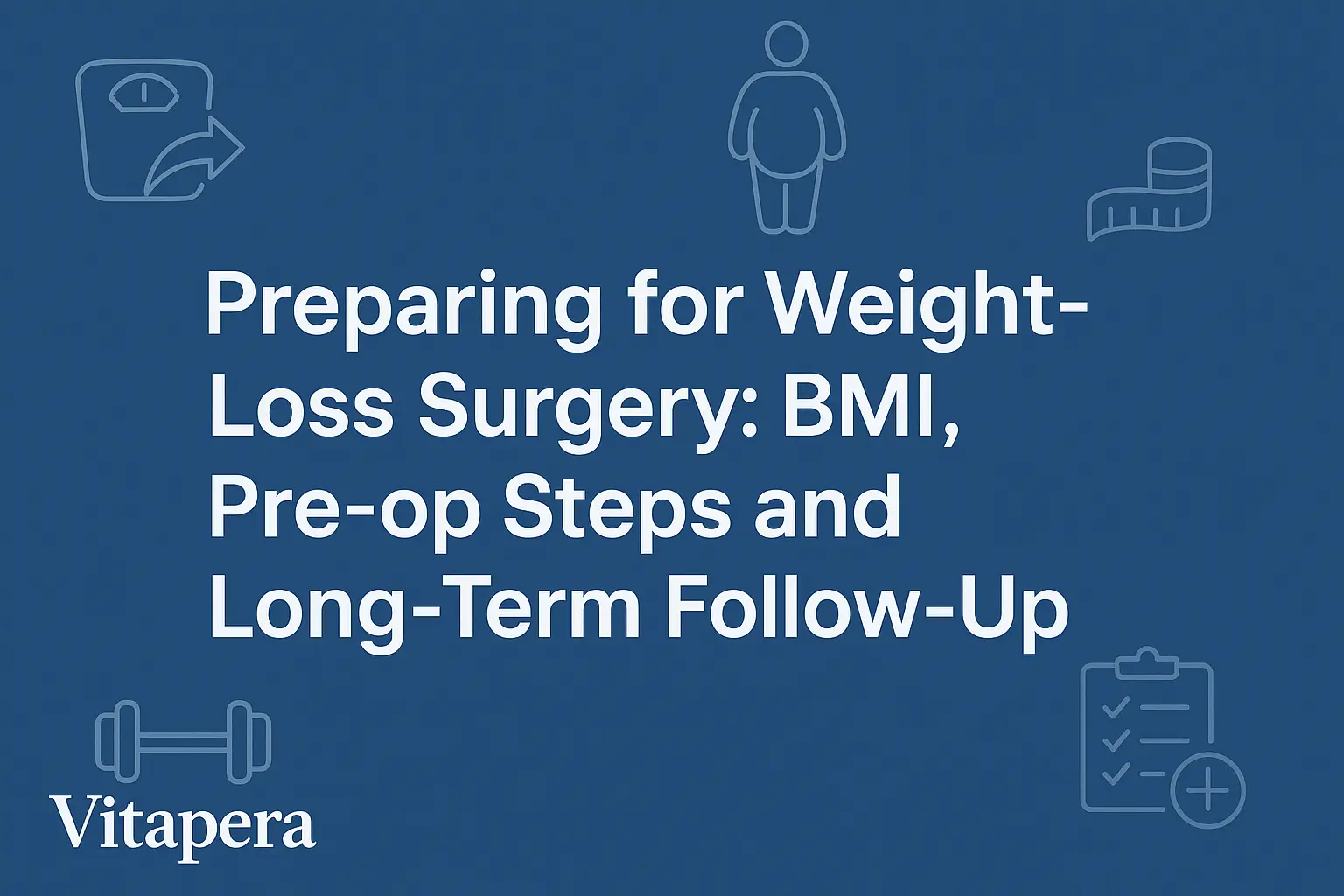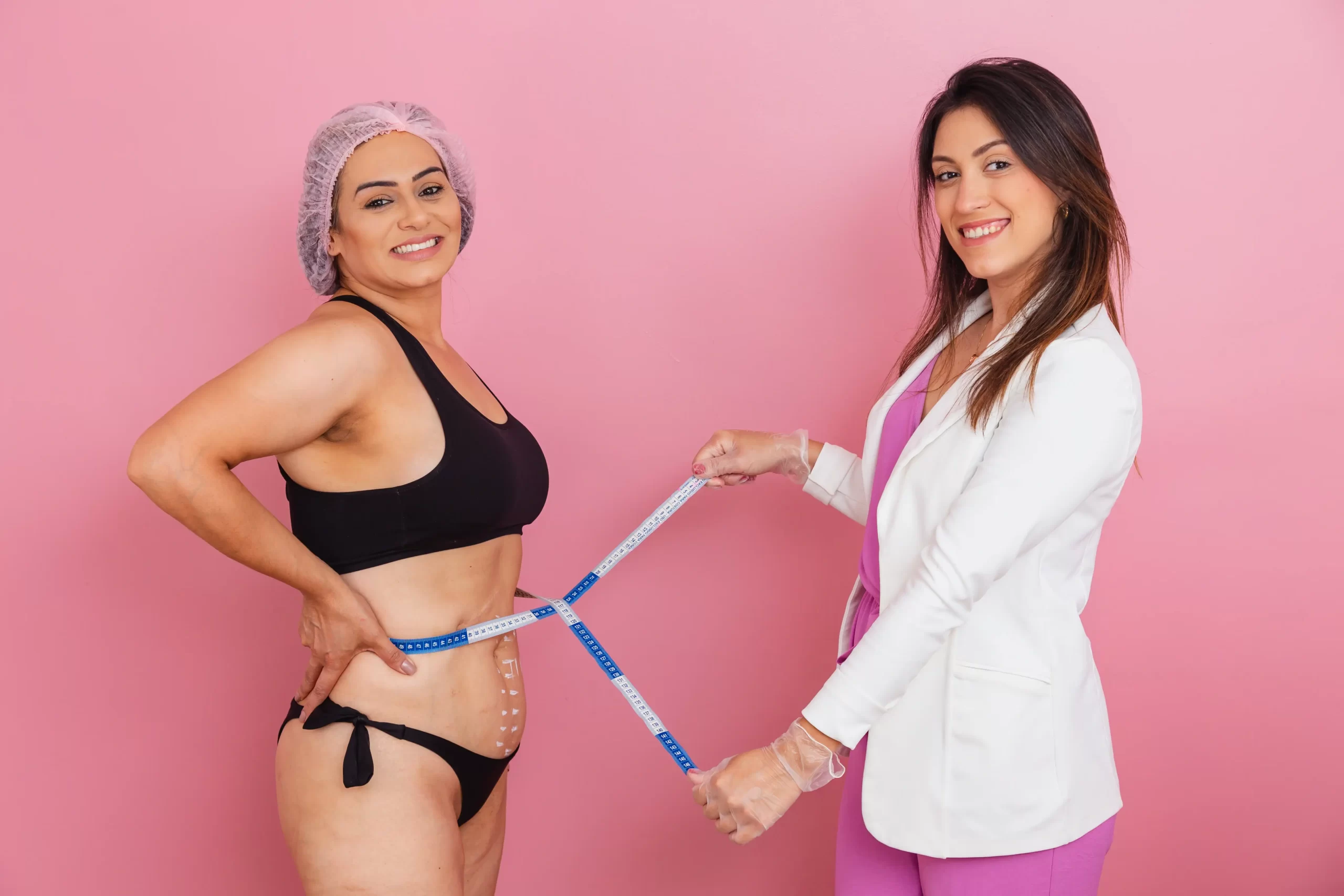A tummy tuck (abdominoplasty) can be life-changing for men and women who struggle with loose belly skin or stubborn fat that won’t go away with diet and exercise. One key part of a tummy tuck is how it affects your belly button. Many patients wonder, “What will my belly button look like after a tummy tuck?” The good news is that with experienced surgeons and careful planning, your navel will be reshaped and repositioned to look natural on your new, flatter abdomen. Vitapera Clinic in Istanbul specializes in abdominoplasty for international patients, and our friendly experts guide you through every step of the journey – from before the operation to after you heal.
In this comprehensive guide, we explain what to expect for your belly button before and after a tummy tuck. We’ll walk through the procedure, recovery, and results, and show why Vitapera’s team makes all the difference for patients traveling from the UK, USA, and beyond. Our goal is to help you feel informed and confident so you can focus on your transformation.
Understanding Tummy Tuck (Abdominoplasty) and Your Belly Button
A tummy tuck is a surgical procedure that removes extra skin and fat from the abdomen and tightens the underlying muscles to create a firmer, smoother stomach contour. It’s often chosen by women after pregnancy or people who have lost a lot of weight and have remaining saggy skin around the belly. Men can also benefit from tummy tucks if they have stubborn belly bulges despite diet and exercise.
One important element of a full tummy tuck is the belly button (navel). Because we are removing and tightening skin above and below it, the belly button itself is temporarily freed from the surrounding skin during surgery. This process is called umbilicoplasty (repositioning of the navel). After the extra skin is removed and the abdomen is pulled tight, a new opening is made in the skin at the correct height for your navel, and the belly button is sutured back into place in an aesthetically pleasing position. This careful repositioning ensures your belly button looks natural on your newly contoured belly.
Vitapera’s experienced plastic surgeons use advanced techniques to reshape and preserve your belly button so that, in the end, it will appear centered and proportional on your flatter stomach. In many cases, the new navel is slightly smaller or more oval, with a smooth, natural-looking border. Although your belly button will have a tiny scar, it is hidden inside the navel itself and usually becomes barely noticeable once fully healed. Meanwhile, the main tummy tuck incision is placed low on the abdomen, right at the bikini line, so any major scar is easily hidden by underwear or swimwear.
Preparing for Surgery: How Your Belly Looks Before
Before surgery, your belly might look very different from what you imagine afterward. Many women notice that pregnancy stretches the abdominal skin and muscles. After childbirth, the belly button can become elongated or appear “pulled” downward. Stretch marks may encircle the navel or be concentrated above or below it. A common issue called diastasis recti (separation of the abdominal muscles) can create a bulge above the belly button, even if you’ve returned to your normal weight. Men who have lost a lot of weight may see loose skin hanging around the waist or a permanently puckered navel.
It’s important to have realistic expectations. Your belly button might have stretched out, and there may be excess skin sagging around it. However, if this loose skin and fat are what bothers you, a tummy tuck can dramatically improve the appearance. A good surgeon will discuss your specific belly shape and what goals you have. At Vitapera, we carefully evaluate the current state of your abdomen – including the belly button, the skin tone, and muscle separation – so we can plan the procedure just for you.
In the weeks leading up to surgery, it’s best to be at a stable weight (as close as possible to your target weight). Tummy tucks are not weight-loss procedures but body-shaping surgeries, so having a BMI (body mass index) in a safe range helps ensure the best results. Stop smoking at least 4-6 weeks before the operation to help with healing. Follow any pre-operative instructions from Vitapera’s medical team, like avoiding certain medications or fasting before surgery. Also, talk to your doctor about any abdominal scars (from C-sections or earlier surgeries) – the surgeon will plan the new incision carefully to incorporate or avoid old scars when possible.
Many patients wonder: “Will my belly button look unnatural or like an outie after a tummy tuck?” In almost all cases at Vitapera, the navel will be an innie and artistically shaped. Surgeons create the new opening for the belly button so that it sits at the right location on your abdomen – typically around two-thirds of the distance from your pubic bone to your upper stomach. This keeps the navel looking natural on a firm, flat stomach.
The Procedure: How the Belly Button is Treated
During a full tummy tuck at Vitapera, you will receive general anesthesia to keep you comfortable and pain-free. Once you are asleep, the surgeon makes a horizontal incision low on your abdomen, usually stretching from hipbone to hipbone. This incision is hidden below the bikini line. Through this incision, excess fat and skin are gently removed from the lower and middle abdomen.
Crucially, the surgeon will free the belly button from the surrounding skin. This means cutting around the navel in a way that preserves blood flow so the tissue stays healthy. The belly button is left attached to the abdominal wall (via its stalk), but it’s essentially isolated as the skin flap above it is tightened down. At this point, the surgeon can tighten any separated abdominal muscles (repairing diastasis) with sutures – this gives core strength and flattens the tummy.
Next, the remaining abdominal skin is pulled downward. Imagine draping a tighter sheet over a mattress: the skin is redraped over the abdomen to smooth out the contour. Because the skin has been pulled down, the original opening where your belly button was no longer matches up. The surgeon will now create a new hole in the tightened skin, carefully cutting around where the navel should be located. This location is chosen based on your body proportions and how high or low your belly button should sit on the new abdomen.
The belly button is then reinserted through this opening. The surgeon stitches the edges of the navel to the surrounding skin so that it sits naturally. This requires precision – the goal is to have the navel centered and shaped attractively. Often, surgeons will make the scar around the navel in a circular or oval pattern that blends into the fold of the skin, so it’s mostly hidden once healed.
Finally, the skin incision across the lower belly is closed with sutures. Vitapera surgeons typically use layered internal stitches, which reduces tension on the outer layer and helps minimize the visible scar. In some cases, surgical mesh or mesh-like sutures might be used to strengthen the repair (especially if someone had a hernia). A compression dressing or abdominal binder is applied to support your new contour, and thin drainage tubes may be placed under the skin to catch any fluid that could collect during the first week.
If you had a mini tummy tuck (for example, if only the area below the belly button needed improvement), the belly button is not moved. A mini tuck makes a shorter incision and doesn’t involve repositioning the navel, so your belly button remains exactly where it was. However, for a classic full tummy tuck or an extended tummy tuck, repositioning the belly button is a standard and important step to achieve a smooth result.
Vitapera surgeons use cutting-edge techniques for umbilicoplasty. For example, many use a “floating” technique, where the belly button is left attached to the skin for a time to make a small incision around it at the end. Others make two small slits (one vertical, one horizontal) to create the navel’s new shape. The end result is a belly button that looks like a small natural dimple or vertical oval, rather than a puckered, horizontal scar. In any case, the patient’s own tissue is used – nothing is implanted, and over time, the new belly button feels like it was always part of your body.
Recovery: Caring for Your New Belly Button
Right after surgery, your abdomen (and belly button area) will be swollen and numb. Don’t worry – this is perfectly normal. The anesthesia and the surgical stretching of skin cause a lot of temporary swelling. You will wake up in the recovery room with dressings over the incisions. You may feel some tightness or soreness in your belly, which pain medication will control. Some pain around the navel is normal too, but not alarming.
Your hospital stay is usually 1–2 nights, depending on the procedure’s extent. During this time, nurses will help you move gently, cough, and deep-breathe to prevent lung congestion. They will also show you how to support your belly and drain tubes (if any). At Vitapera, our international patient coordinators and nurses make sure you are comfortable and understand every step, even if it’s your first surgery in a foreign country.
Once at home or your hotel, you will wear a compression garment (abdominal binder) most of the day for the first 4–6 weeks. This gentle pressure supports your healing tissues and reduces swelling. Keep yourself on a liquid/soft diet initially if recommended, but eating a normal, healthy diet that’s high in protein can actually help your body heal faster.
Caring for Your Belly Button Area
- Keep it clean and dry: Your belly button will have small stitches around it. For the first week or two, these sutures (if non-dissolving) will hold the edges together. You might have a little white glue or tape covering the navel. Follow your doctor’s instructions: usually, you can shower gently after 2–3 days, letting water run over the incisions. Pat the area dry with a clean towel; avoid rubbing. Sometimes surgeons give an antibiotic ointment to apply a few times a day to the navel stitches for the first week.
- Bathing: Do not take baths or swim until your surgeon says it’s okay (typically after 3–4 weeks). The belly button area needs to stay dry enough to heal without risk of infection.
- Watch for signs of infection: It’s common for there to be some redness and slight fluid under the skin right after surgery. But if you notice increasing redness, warmth, foul-smelling discharge, or if you develop a fever, call your doctor. Vitapera provides 24/7 support lines – we are just a message or call away if you have any concerns.
- Comfort level: The belly button itself may feel numb or even tingly at first. Nerve endings were stretched or cut during the procedure, and they take time to regenerate. It’s normal not to feel much around the navel for the first few weeks or even months. Over time, sensation usually returns. You might also have minor itchiness as it heals – a sign of normal recovery.
Stitches and Drains
- Drains: If you had surgical drains, they will usually stay in place for about a week, collecting excess fluid. You (or your nurse) will empty and measure the output each day. When the flow slows down, the drain is removed (a quick in-office procedure).
- Stitches: If non-absorbable sutures were used around the belly button, they are often removed 10–14 days after surgery. Before that, keep the area clean to allow the stitches to hold. Dissolvable stitches usually are gone by the time you see the doctor for a check-up.
Weeks 2–4: Adjusting
After the first week, you should notice the tightness in your belly easing slowly. Many patients can return to light, desk-type work by weeks 2–3. You will still be wearing the binder most days. Most swelling resolves during these weeks, though it can come and go depending on your activity and time of day. By now, the major bruising (if any) should be gone or fading.
During this period:
- Scar care: The new scar around your navel is fresh. It might look a bit red or pink. Your surgeon may suggest starting silicone gel or sheets on both the main incision and the navel to help it heal flat. Vitamin E oil or over-the-counter scar creams can also be applied once the stitches are out to soften the skin.
- Mobility: You’ll be able to stand more upright, though you should still avoid full extension that strains the incision. Walk daily to improve circulation, but skip strenuous exercise. Vitapera provides clear guidelines on activities to avoid: generally, no heavy lifting or abdominal workouts for 6–8 weeks.
- Follow-up: Your surgeon will have you in for a check-up (in person or via video) around 1-2 weeks post-op to remove drains, change dressings, and ensure everything is healing well.
Long-Term Healing (Months 2–6)
It can take several months for your body to fully adjust to its new shape. The belly button will gradually take on its final form as swelling subsides completely. It might have looked a little tight, round, or smaller than expected in the first month, but over the next 2–3 months it usually relaxes to the ideal size and shape. The skin around it becomes more supple, and any pulling feels better.
By 2–3 months, you should be feeling much more comfortable in your clothes, and things like zippers or belts will fit differently – usually looser! The incision scar will start turning from red to pink to a pale line. By six months to a year, the scar should blend more with your skin tone and lie flat. The belly button will remain a small, vertical shape – often described as looking “younger” or more shapely than before, since it is now located on a firmer tummy.
Vitapera’s doctors will continue to monitor your progress. We provide follow-up check-ins to see how you’re doing, and we’re happy to answer any “after” questions. Many patients send us photos or have additional office visits after they return home, just to make sure the belly button looks perfect. Our team is proud to help you achieve a navel that you can feel confident showing off in a bikini or even a crop top!
Before-and-After Transformations: What You Can Expect
While individual results vary, we can describe common changes seen in tummy tuck patients’ belly buttons and stomachs:
- Before: You might have a sagging lower belly, bulging loose skin around the navel, or a belly button that appears stretched out (sometimes horizontally). Stretch marks might frame the belly button. The abdominal muscles could be separated, creating a ridge from the ribs down to the pubic area.
- After: Excess skin below the belly button is gone, the stomach is smooth, and the waistline is narrower. The belly button now sits at an ideal height, with an oval or teardrop shape that matches the flat contour around it. Any stretch marks that were on removed skin are gone; those still above the navel may look less noticeable on the firmer skin. You’ll have a tighter, toned midsection and a shapely navel.
Imagine a patient who had a low, drooping belly button before. After the tummy tuck, her new belly button appears more “upside-down teardrop” shaped, and it’s centered on a flat stomach with no loose skin hanging down. She might notice that when she wears underwear or shorts, the waistband now sits high on her hip bones without catching on extra skin. Her belly button looks like it always belonged on this firmer tummy. Many of our patients say they feel more feminine and confident wearing swimwear after seeing this transformation.
Patient satisfaction is high with tummy tucks, especially when realistic expectations are set. Studies show most people feel a big boost in confidence and quality of life after abdominoplasty. They love being able to wear fitted clothing again and no longer feel self-conscious about their midsection. Of course, every body is unique. Factors such as your skin elasticity, body mass index, and genetics can influence the exact outcome. Vitapera’s team will discuss these details with you honestly so you know what results to anticipate.
Who is a Good Candidate?
If you have good overall health and want to get rid of a bulging or sagging belly, a tummy tuck may be right for you. Ideal candidates:
- Women post-pregnancy: Once you’re done having children, a tummy tuck can help flatten the tummy and tighten muscles that pregnancy stretched. It removes pregnancy-related loose skin that won’t go away on its own.
- Post-weight-loss: If you lost a significant amount of weight (through diet, exercise, or bariatric surgery) and have hanging belly skin, abdominoplasty can remove that excess skin.
- Separated muscles: If you have diastasis recti, a tummy tuck can sew those separated muscles together, strengthening your core.
- Stubborn fat pockets: People of normal weight who have localized fat deposits around the lower belly that don’t respond to diet may consider an abdominoplasty plus liposuction.
- Men: Though tummy tucks are more common in women, men with excess belly fat or skin from aging or weight loss can also benefit. The procedure is performed similarly, but surgeons account for male anatomy (for instance, the belly button shape may be slightly rounder for men).
You should be close to your ideal weight before surgery, and have maintained that weight for at least 6–12 months. For women, it’s best if you don’t plan future pregnancies; an additional pregnancy would likely undo the effects of the surgery. Also, candidates should not be smokers – smoking reduces blood flow and dramatically increases healing complications. At Vitapera, we might perform a quick pre-op test (like an EKG or lab work) to ensure you’re safe for anesthesia and surgery.
It’s important to understand that a tummy tuck is not a substitute for overall weight loss or a healthy lifestyle. We advise you to try diet and exercise first. If after disciplined effort you still have a significant overhang of skin or fat, that’s when abdominoplasty can be the next step.
Benefits of a Tummy Tuck
A well-done tummy tuck offers multiple advantages beyond aesthetics. Here are some of the key benefits:
- Flatter, firmer abdomen: By removing excess fat and skin, your stomach becomes flat rather than bulging or sagging. The belly button becomes surrounded by taut, smooth skin.
- Tightened core muscles: Separated abdominal muscles (common after pregnancy) are sutured together during surgery, strengthening the core. This can improve posture and back support.
- Enhanced belly button shape: The repositioned navel is carefully shaped so it looks natural and in proportion to your new waistline. Many patients find they get a “youthful” looking belly button after.
- Removal of stretch marks: Stretch marks on removed skin (often those below the belly button) are eliminated. Stretch marks above the navel remain but often appear less noticeable on the smoother skin.
- Improved confidence: With a toned midsection, patients often feel much more comfortable in clothing, swimwear, and intimate situations. Research confirms that most people report higher self-esteem and quality of life after a tummy tuck.
- Better posture and comfort: Strengthening the abdominal wall can ease back pain and allow for improved posture. Many patients also sleep better and enjoy exercise more when their core feels stable.
- Long-lasting results: As long as you maintain your weight, the surgical improvements are permanent. Unlike weight loss surgeries, abdominoplasty does not dramatically affect your weight, but it reshapes the area.
At Vitapera, we encourage patients to think about the tummy tuck as an investment in their well-being. The slimming of the waistline can make clothes fit better, and many find that they can again wear styles they thought were off-limits. We’ve had mothers marvel at how they feel like themselves again, and men amazed to regain a flat stomach after years of wearing loose shirts to hide their belly.
Choosing Vitapera Clinic for Your Tummy Tuck
When it comes to cosmetic surgery, especially from abroad, choosing the right clinic is as important as the procedure itself. Vitapera Clinic in Istanbul is a top choice for UK and US patients looking for high-quality tummy tuck surgery. Here’s why:
Expert Surgeons: Our plastic surgeons are board-certified with international training and years of experience in body contouring. They specialize in tummy tucks and perform them regularly, so each patient benefits from their refined skill. They understand the nuances of belly button repositioning and design it to complement your unique anatomy.
Internationally Accredited Hospitals: Vitapera partners only with modern hospitals that have international accreditations (like JCI and ISO). This means they meet global standards for patient safety, hygiene, and medical care. You get the benefits of Turkey’s medical tourism excellence without compromising quality.
Comprehensive Packages: We offer all-inclusive surgery packages that cover everything you need, often for the cost of surgery alone in the UK or USA. Typically included are pre-operative tests, the surgery itself, nursing care, anesthesia, post-op check-ups, and even hotel stays and airport transfers. Our prices can be 60–80% lower than in Western clinics, but the quality is just as high.
Personalized Support: From your first inquiry, Vitapera’s English-speaking patient coordinators are there to assist you. We explain every detail, help plan your trip to Istanbul, and match you with the right surgeon. On-site, you’ll have someone who can translate medical information (if needed) and guide you through the recovery process.
Modern Facilities & Technology: Our operating theaters use advanced surgical technology and equipment. Sterile techniques and anesthesia monitoring are on par with the best hospitals worldwide. This means safer procedures and often quicker recoveries.
Patient Satisfaction: Dozens of international patients give Vitapera high ratings and positive feedback. Our clinic prides itself on a seamless, comfortable experience. Many patients remark on how caring and attentive the staff are, and how their surgeons listen to their goals.
Post-Operative Care: After the surgery, we don’t just send you on your way. Our team stays in touch with you even when you return home. You’ll get detailed aftercare instructions, our contact info, and sometimes follow-up video calls. If you travel from the UK or USA, we may advise you to stay in Istanbul for 7–10 days for initial healing and drain removal before returning home.
Choosing Vitapera means choosing a clinic that understands the full journey of a cosmetic patient – from consultation to recovery. Many patients appreciate that Vitapera is transparent; there are no hidden fees or surprises. Our goal is to make your tummy tuck as easy and successful as possible.
Traveling to Turkey for Your Surgery
You might wonder about flying overseas for surgery. Turkey, and Istanbul in particular, is a world-renowned hub for medical tourism. Istanbul is a modern city with international airports and many English speakers, so you’ll find it comfortable and convenient. Flights from the UK to Istanbul are only about 4 hours, and even from the East Coast of the USA it’s around 10–12 hours, which is easily broken up with a layover if needed.
Here’s what to expect when you travel for tummy tuck surgery at Vitapera:
- Language: Our entire medical team speaks English fluently. All your medical forms, consultations, and aftercare instructions will be in English. Most Istanbul hospitals have English staff as well. You won’t have to worry about language barriers during your treatment.
- Comfortable Accommodation: Vitapera can recommend or provide comfortable hotel accommodations near the hospital. Many patients bring a companion, and we often book suites that have space for recovery and relaxing after the procedure. Some hotels even offer discounts for medical guests.
- Tourism: After your initial 7–10 days of recovery, many patients enjoy exploring Istanbul. It’s a culturally rich city with famous sights like the Hagia Sophia and the Grand Bazaar. If you have extra time, our team can suggest gentle activities that won’t strain your abdomen (for example, scenic boat rides or museums).
- Cost-Effectiveness: Even with flights and a hotel, the all-inclusive cost of surgery in Turkey is usually much lower than paying for surgery alone in the UK/USA. Vitapera’s transparent pricing helps you budget: you’ll know exactly what’s included (surgery, hospital, hotel, transfers) from the start.
- Safety: The environment is safe for international patients. The hospitals take every precaution for post-COVID safety measures and general infection control. You’ll be in a secure medical environment.
We handle all the logistics. Before your trip, Vitapera sends you a detailed itinerary (which may include surgeon meeting, medical tests, and procedure schedule). We also guide you on what to pack (compression garments, loose clothing, etc.) and advise on travel insurance.
Cost and Value
It’s impossible to deny the value of getting high-quality surgery at a great price. At Vitapera, a tummy tuck package might start around the equivalent of £2,200 or a few thousand dollars – which often covers not only the surgery but also accommodations, anesthesia, nursing, and other fees. In the UK or US, a similar surgery could easily cost 2-3 times as much without any of these extras.
To break it down:
- All-Inclusive Pricing: One price often covers: surgeon’s fee, anesthesiologist, hospital charges, pre-op tests (blood work, ECG), medications during your stay, post-op care, hospital stay (usually 1-2 nights), and even a few nights in a hotel with meals.
- No Hidden Charges: Unlike some places where room upgrades or nursing care cost extra, Vitapera’s packages are comprehensive. There won’t be surprise bills at the end.
- Travel Perks: Some clinics only do the surgery. Vitapera often includes airport transfer and in-hospital translation. This is excellent value if you would otherwise pay for a translator or extended hospital stay at home.
- Follow-up: Vitapera also includes follow-ups as part of your package. We check your healing progress at no extra cost beyond the package fee.
We emphasize that quality is not compromised for cost. You get the same (or better) level of care as Western Europe or North America. The only reason the price is lower is Turkey’s generally lower medical and operational costs. Vitapera reinvests its revenue into state-of-the-art facilities and ongoing training, so you truly get a world-class surgery at a great price.
Our goal is not just to give you a flatter tummy but also to give you a great overall experience. After all, traveling abroad for surgery takes courage. We want to reward that trust by delivering exceptional results and service.
Conclusion: Transform Your Belly with Confidence
A tummy tuck at Vitapera Clinic can turn the frustration of a stubborn belly into a story of transformation and confidence. You’ll start this journey with a loose, stretched-looking belly button (common after pregnancy or weight changes) and end with a firm abdomen and a beautifully reshaped navel that looks natural and centered. Most importantly, many people report feeling happier and more confident in their body image after healing is complete.
If you’re a woman who wants to restore a pre-pregnancy figure, or a man who wants to sculpt a slimmer waistline, Vitapera’s expert team is ready to help. We combine skillful surgery with compassionate care, giving you the best outcome possible. Our Istanbul clinic has served thousands of international patients just like you, helping them achieve amazing before-and-after results.
Ready to learn more? Vitapera offers free consultations where our surgeons review your case and explain all the details. We’ll discuss your goals, examine your abdomen, and advise on the best tummy tuck approach – whether that’s a mini tuck, standard tummy tuck, or even an extended abdominoplasty if needed. You’ll have the chance to ask anything about what happens to your belly button, recovery timeline, and what to expect when you return home.
Your journey to a flatter, firmer tummy and a refreshed belly button can begin today. At Vitapera Clinic, we specialize in making this transformation as smooth and rewarding as possible, with results that speak for themselves. Contact us to take the first step, and imagine how good it will feel to look in the mirror and love your new midsection.










